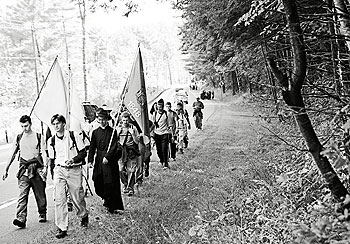Life on pilgrimage just got better.
In response to years of requests from pilgrims young & old, the Pilgrimage to Auriesville offers an exciting new opportunity.
Mark your calendar.
The 16th annual Pilgrimage for Restoration is scheduled for 23-25 September 2011.
The new dates & days, Friday through Sunday, have the event now take place over a ‘long weekend’.
That will make it easier than ever for collegians, home-schoolers & high-schoolers, working families and just about everybody to participate.
The only change will be to the last day of pilgrimage, on the third day, this year a Sunday. Instead of turning west after lunch to the Shrine of Blessed Kateri Tekakwitha, the pilgrimage will head due south, directly to the Shrine at Auriesville.
The turn will make the pilgrimage 12.5 miles shorter, and bring everyone to the final shrine destination a day earlier.
The new path eliminates the customary stop-over at the Kateri Shrine. But that will hardly mean a change in veneration to one of the Pilgrimage’s most beloved patronesses. Neither will it exclude newcomers from joining up the last day of pilgrimage.
Just the opposite. It will make the Pilgrimage for Restoration much more like the model and inspiration, the Paris-to-Chartres Pentecost Pilgrimage. And Blessed Kateri will receive due and even improved veneration already in planning.
The French counterpart is 62 miles long (100 kilometers according to their website.) Most pilgrims there join the last day, Pentecost Monday, at around lunch-time.
Organizers of the annual Pilgrimage for Restoration are already planning something similar for the last day, now a Sunday.
In fact, there’s something already in the works for everybody.
Check it out.
And check back soon for updates.



